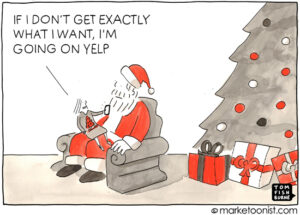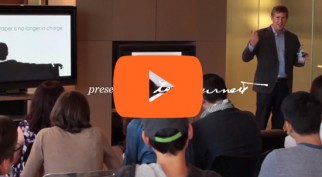Forrester recently released a report on the future of push notifications (those messages that apps send to your mobile device).
“Moving forward, we expect to see push notifications integrated as a core component of any direct marketing and relationship program.”
That goes for mobile devices, but also for all of the other connected devices like TVs, cars, and game consoles. Two TV operators are planning to launch push notifications soon.
Push notifications are seen by mobile marketers as the holy grail. They’re inexpensive, very measurable, highly targeted, less interruptive than SMS, and harder to lose than an email. All of this leads to a high marketing ROI.
But push notifications can also be annoying as all hell.
Irrelevant, non-targeted push notifications can drive consumers as crazy as the guy in this cartoon. Push marketing is a powerful marketing tool, but it can easily be abused. Brands should tread carefully.
Brent Hieggelke, CMO at Urban Airship, wrote a useful article on the difference between “good push” and “bad push”. Brands like Airbnb and Rue La La are successfully using push notifications to connect with their audiences in meaningful and effective ways.
Ultimately, as with all marketing tools, brands need to realize that communicating with an audience is a privilege. Just because consumers automatically opted in to push notifications doesn’t mean a brand has earned that privilege. If a brand is going to interrupt a consumer with a marketing message, that message had better be worth it (not just to the brand, but to the consumer).
(Marketoonist Monday: I’m giving away a signed print of this week’s cartoon. Just share an insightful comment to this week’s post by 5:00 PST on Monday. Thanks!)



Ty says
Push messages, EMail clubs, etc. are great for customer retention, but they do very little for new customer acquisition.
Corey says
Nothing can delight or annoy as much as push notifications because they light up peoples’ most personal screens. Having sent 100 billion pushes for our customers, we spend a lot of time focusing on best practices and targeting to ensure the messages are as personally relevant as possible. However, sometimes it is seeing the epic fails that really brings the lesson home, and you can check out our Bad Push booklet here: http://urbanairship.com/blog/2013/10/03/bad-push-brand-fails.
Olyvia says
I’m currently just starting out as a marketing intern at a well-known TV network, but I can best speak from a customer perspective. I am definitely hesitant to opt into PUSH notifications with my apps because I feel like many brands do abuse it with marketing messages that aren’t beneficial to me.
Concetta says
I am with Olyvia. Even though I understand the marketing, I know how much brands do push notifications without care, and therefore, it makes me hesitant to try them. There’s nothing more annoying then being in a meeting, having my phone buzz and seeing its a brand tell me its time to go find them.
One app that I think handles this very well is Ibotta – they send out selective push notifications and there’s always something clear to do/find/explore rather than just “Hi! I’m here! Pay attention to me!”
Paul says
Our customers experienced that the secret behind non-annoying push notifications is to send them location based. In this way users only receive your messages when they can immediately act upon them. These location based notifications have huge conversions and are highly appreciated by users. See the infographic ‘Who needs coffee while sleeping?’ http://www.plotprojects.com/whoneedscoffeewhilesleeping/
Sarabjeet says
It’s just another annoying way for most marketeers to get in touch with their potential consumers.
As with a lot of digital initiatives, the CMO of the month feels the need to be tech enabled and thinks this is something he/she can use to show his/her tech savvy to the board/hierarchy.
I may be wrong, but the message should be relevant to the end consumer – weather it is location based (great link, by the way), or other wise – I think most brands miss that point.